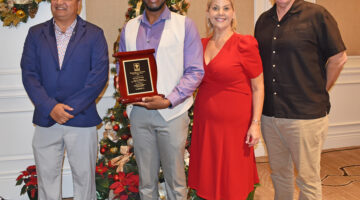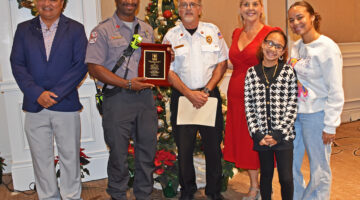Howelings
Our Two Tonys in the Geographic
As everyone should know in the Keys by now, two local Key West characters have been featured in a recent edition of the National Geographic.
The story in the July issue was titled “Big Fish,” which did not necessarily refer to the two people in question but actually to the goliath grouper, asking the question, will the 800-pound fish sink or swim?
Illustrating the article, written by nature reporter Jennifer S. Holland, author of “Unlikely Heroes,” is a 1958 photo courtesy of Monroe County Library showing none other than Tony Tarracino, replete with bare chest and captain’s cap, together with his family, including a young daughter, lined up on a sunny Key West dock with “a day’s catch” featuring several truly giant grouper hanging from their mouths beneath a wooden sign that reads, “Caught on Boat Greyhound II, Key West, Florida.”
The caption concludes, “Recreational hauls of goliaths helped push them near extinction.”
This species whose scientific name is Epinephelus itajara was once populous in the waters of the southern United States and the Caribbean and all the way down to Brazil, numbering in the tens of thousands. But after years of being “speared and hooked by the boatload,” writes Holland, “their numbers have dwindled to an unknown low, perhaps below a thousand.”
The Florida population, however, has rebounded and continues to do so, encouraging fishermen, biologists and local government officials to declare the possibility of shedding their legal protection from “people wielding spear guns and fishing lines.”
Meanwhile Chris Koenig of Florida State University is proposing that it’s the grouper’s own behavior that has undeniably contributed to its population drop. “Ordinarily these fish don’t move a whit,” he says, “glued to the reef” where food and shelter are plentiful, making them easy targets. Adds 86-year-old Frank Hammet, who spent much of his 20s with spear gun in hand, “You could see them sitting on the bottom in 100 feet of water. The reefs were covered with them. There might be hundreds in a single spot or a wall of them — something you don’t forget! I’d shoot one or two, get eight cents a pound for them. I did that for 15 years or more.”
Apparently the grouper’s commercial appeal was largely regional at the time; in the Keys, goliath grouper with black beans and rice was considered a special delicacy. But when fish stocks in general waned in the early 1980s, “goliaths landed on menus everywhere,” reports Holland. They also became a recreational favorite for their spectacular size and many of them died as trophies. “Long-lived and slow to mature, the species simply couldn’t keep up with the slaughter. It teetered on the edge of extinction.”
But it did not fall. In 1990, the goliath was granted legal protection in the Southeastern United States. It has been slowly rebuilding its numbers ever since. The biggest recovery has been in local waters, with our thick mangrove forests, a favored home of the juveniles.
Now comes the part where the other one of our two colorful Key West figures in the National Geographic story makes his appearance: None other than Tony Yaniz.
Here is Holland’s text, verbatim: “As often happens in the world of conservation, there are two distinct sides on the issue of goliaths. Still considered critically endangered in much of their range, goliaths in Florida remain legally off limits. ‘The political pendulum has swung so far toward protection that you can’t even touch or look at one,’ says Key West City Commissioner Tony Yaniz. ‘You’re better off getting caught with bales of marijuana than with one of these fish.’”
The irony runs thick at this point. Fishermen are now saying that the return of the goliath in such droves is interfering with legitimate business. “We have goliaths taking legal grouper and snapper right off our lines, over and over,” says commercial fisherman and guide Jim Thomas. He is one of many who want to be able to fish for goliaths — even just a few annually — in order to thin out the alleged thieves. “It doesn’t have to be a one-sided benefit,” Yaniz adds. Why not, he proposes, have the fishermen contribute to answering conservation questions by providing data on the numbers and sizes of fish? “They’re the ones out there every day, with eyes on the water. They can really help us figure out where the species stands.”
Holland’s conclusion to her National Geographic story is not uplifting.
“However successful their mating, a return to historic high numbers may be just a dream for the big fish.” Scientists, she reports, are saying exposure to mercury is having an insidious toxic effect on the goliath, leading to lesions in the liver of adults. “We shouldn’t be eating these things,” she suggests.
And the future of goliaths is also tied up in those mangrove nurseries, where the fish live around the trees’ tangled roots until they are about five years old. But coastal development, agriculture and pollutants threaten these shallow-water habitats. The present trajectory suggests 20 percent losses of remaining U.S. mangroves in the next 50 years — devastating for young, developing goliaths, which are already reeling from unusually cold winters that took out thousands of the fish from their juvenile habitat throughout South Florida.
Our conclusion: Go goliath! Be grand! Give it all you’ve got!
*****
One of the largest creatures ever caught in the Keys was a 38-foot-long, 26,594-pound whale shark that took about 39 hours, five harpoons and more than 100 bullets to subdue by Capt. Charles Thompson of Miami aboard his boat off Knight’s Key.
It was towed to Miami, preserved and stuffed and exhibited on a railroad flat car until it was accidentally destroyed by fire in 1922.
(Thanks to Jim McManus and Jackne for this item.)
*****
Quote for the Week:
“Many men go fishing all of their lives without ever knowing that it was not fish they were after.”
— Henry David Thoreau
(July 12, 1817 – May 6, 1862)
[livemarket market_name="KONK Life LiveMarket" limit=3 category=“” show_signup=0 show_more=0]







The Goliath Grouper story is sadly typical of so much global environmental and ecological deterioration. The black and white photos from the Key West docks in the forties and fifties are a testimony to our inability to practice conservation until it is too late. We are the champs of knee jerk. Yes, dubious fame in Nat Geo. Love the Thoreau quote! Thanks!